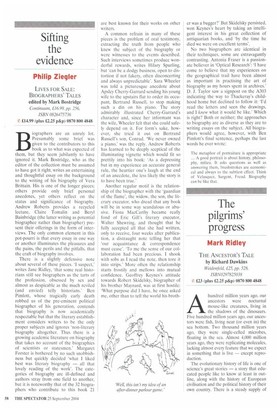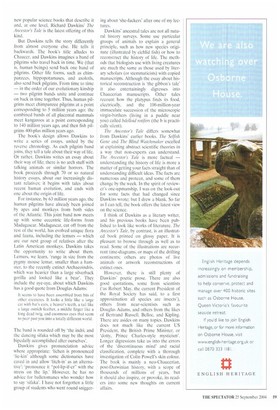The pilgrims' progress
Mark Ridley
THE ANCESTOR'S TALE by Richard Dawkins Weidenfeld, £25, pp. 528, ISBN0297825038 ( £23 (plus £2.25 p&p) 0870 800 4848 Ahundred million years ago, our ancestors were nocturnal mouse-like creatures, living in the shadows of the dinosaurs. Five hundred million years ago, our ancestors were fish, living near (or even in) the sea bottom. Two thousand million years ago, they were single-celled microbes, floating in the sea. Almost 4,000 million years ago, they were replicating molecules, lacking almost every feature that we expect in something that is live — except reproduction.
The evolutionary history of life is one of science's great stories — a story that educated people like to know at least in outline, along with the history of European civilisation and the political history of their own country. There is a steady supply of new popular science books that describe it and, at one level, Richard Dawkins' The Ancestor's Tale is the latest offering of this kind.
But Dawkins tells the story differently from almost everyone else. He tells it backwards. The book's title alludes to Chaucer, and Dawkins imagines a band of pilgrims who travel back in time. We (that is, human beings) send back one band of pilgrims. Other life forms, such as chimpanzees, hippopotamuses, and axolotls, also send back pilgrims. From time to time — in the order of our evolutionary kinship — two pilgrim bands unite and continue on back in time together. Thus, human pilgrims meet chimpanzee pilgrims at a point corresponding to 5 million years ago: the combined bands of all placental mammals meet kangaroos at a point corresponding to 140 million years ago, and then fish pilgrims 400-plus million years ago.
The book's design allows Dawkins to write a series of essays, united by the reverse chronology. As each pilgrim band joins, they tell a tale about their way of life. Or rather, Dawkins writes an essay about their way of life; there is no arch stuff with talking animals or similar horrors. The book proceeds through 70 or so natural history essays, about our increasingly distant relatives; it begins with tales about recent human evolution, and ends with one about the origin of life.
For instance, by 63 million years ago, the human pilgrims have already been joined by apes and monkeys from both sides of the Atlantic. This joint band now meets up with some eccentric life-forms from Madagascar. Madagascar, cut off from the rest of the world, has evolved unique flora and fauna, including the lemurs — which are our next group of relatives after the Latin American monkeys. Dawkins takes the opportunity to write about them. Lemurs, we learn, 'range in size from the pygmy mouse lemur, smaller than a hamster, to the recently extinct Archaeoindris, which was heavier than a large silverback gorilla and looked like a bear'. They include the aye-aye, about which Dawkins has a good quote from Douglas Adams: It seems to have been assembled from bits of other creatures. It looks a little like a large cat with bat's ears, a beaver's teeth, a tail like a large ostrich feather, a middle finger like a lone dead twig, and enormous eyes that seem to peer past you into a totally different world.
The band is rounded off by 'the indri, and the dancing sifaka which may be the most bipedally accomplished after ourselves'.
Dawkins gives pronunciation advice where appropriate: 'lichen is pronounced lie-kin' although some dictionaries have caved in and allow litch-in' as an alternative'; 'pronounce it "pal-lip-if-er with the stress on the lip.' However, he has no advice for balletomanes who wonder how to say 'sifaka'. I have not forgotten a little group of students who went round snigger
ing about 'she-fuckers' after one of my lectures.
Dawkins' ancestral tales are not all natural history surveys. Some use particular groups of animals to explain a general principle, such as how new species originate (illustrated by cichlid fish) or how to reconstruct the history of life. The methods that biologists use with living creatures are much the same as those used by literal), scholars (or stemmaticists) with copied manuscripts. Although the essay about historical reconstruction is 'the gibbon's tale' it also entertainingly digresses into Chaucerian manuscripts. Other tales recount how the platypus finds its food, electrically, and the 100-million-year immaculate succession of the microscopic virgin-birthers (living in a puddle near you) called bdelloid rotifers (the b is practically silent).
The Ancestor's Tale differs somewhat from Dawkins' earlier books. The Selfish Gene and The Blind Watchmaker excelled at explaining abstract scientific theories in a way that non-experts can understand. The Ancestor's Tale is more factual — understanding the history of life is more a matter of getting your facts straight than of understanding difficult ideas. The facts are numerous and protean, and some of them change by the week. In the spirit of reviewer's one-upmanship, I was on the look-out for some facts that had changed since Dawkins wrote; but I drew a blank, So far as I can tell, the book offers the latest view on the science.
I think of Dawkins as a literary writer, and his previous books have been published to look like works of literature. The Ancestor's Tale, by contrast, is an illustrated book printed on glossy paper. It is pleasant to browse through as well as to read. Some of the illustrations are recurrent time-diagrams, or maps of the drifting continents; others are photos of live animals or artwork reconstructions of extinct ones.
However, there is still plenty of Dawkins' poetic prose. There are also good quotations, some from scientists ('as Robert May, the current President of the Royal Society has said, to a first approximation all species are insects'), others from near-scientists such as Douglas Adams, and others from the likes of Bertrand Russell, Belloc, and Kipling. There are asides on many topics. Dawkins does not much like the current US President, the British Prime Minister, or 'dotty, Prince Charles-style mysticism'. Longer digressions take us into the errors of the 'discontinuous mind' and racial classification, complete with a thorough investigation of Colin Powell's skin colour. The book is mainly a neo-Chaucerian, post-Darwinian history, with a scope of thousands of millions of years, but it should also inspire, or provoke, its readers into some new thoughts on current affairs.



























































































 Previous page
Previous page